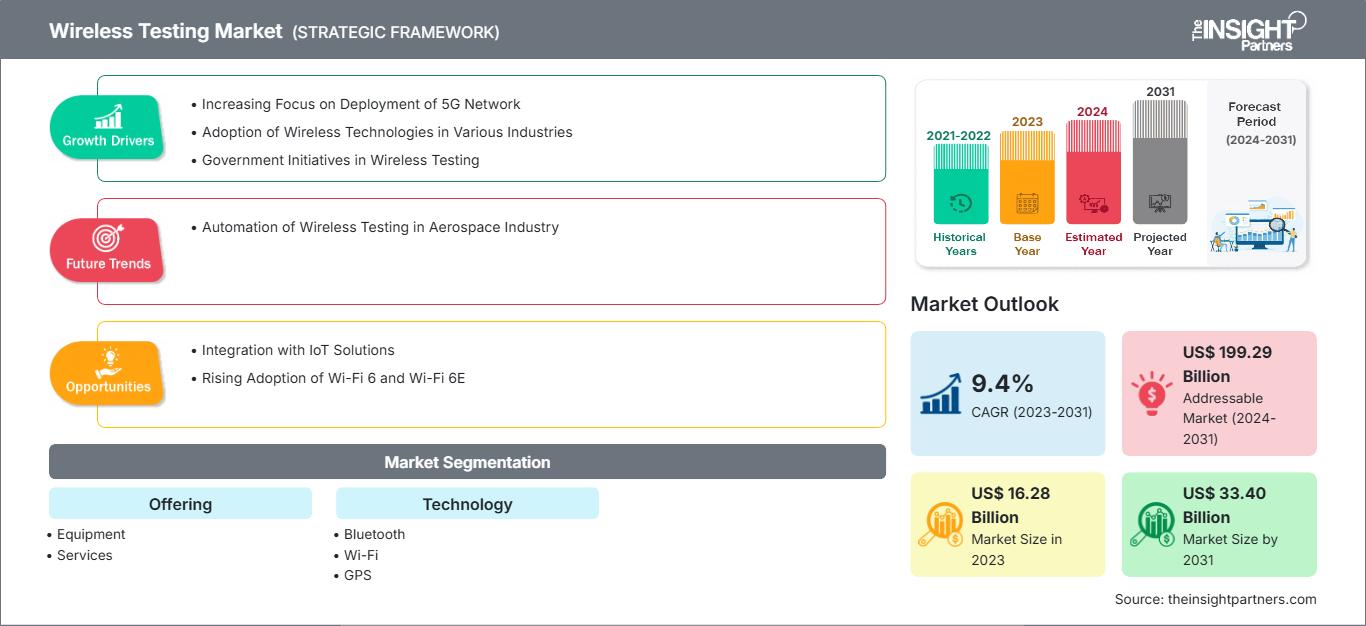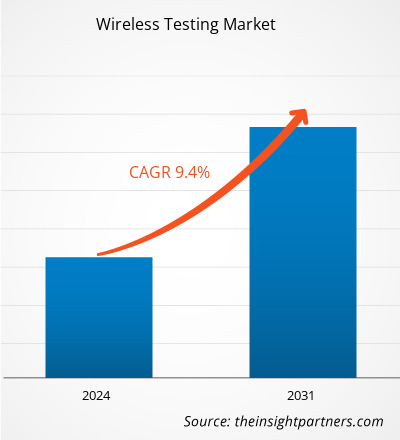Der Markt für Wireless-Tests soll von 16,28 Milliarden US-Dollar im Jahr 2023 auf 33,40 Milliarden US-Dollar im Jahr 2031 anwachsen. Von 2023 bis 2031 wird ein durchschnittliches jährliches Wachstum (CAGR) von 9,4 % erwartet. Die zunehmende Verbreitung von Wireless-Technologien in verschiedenen Branchen dürfte ein wichtiger Markttrend sein.
Marktanalyse für Wireless-Tests
Anbieter von Wireless-Testdiensten sind wichtige Akteure im Ökosystem des Wireless-Testmarkts. Sie stellen sicher, dass Geräte und Netzwerke die angegebenen Leistungs-, Interoperabilitäts- und Sicherheitsstandards erfüllen. Im Ökosystem des Wireless-Testmarkts bieten die Anbieter das erforderliche Fachwissen und die Ressourcen für eine umfassende Bewertung. Anritsu Corporation, EXFO, Intertek Group Plc und SGS SA sind die wichtigsten Anbieter von Wireless-Testdiensten. Diese Testdienste verwenden fortschrittliche Methoden, die reale Umgebungen simulieren, um zu testen und zu bestimmen, wie verschiedene Geräte innerhalb eines Netzwerks miteinander interagieren. Umfangreiche Leistungstests helfen, Kennzahlen wie Signalstärke, Latenz und Datendurchsatz zu messen – allesamt unerlässlich für einen effizienten und zufriedenstellenden Betrieb.
Hersteller von Wireless-Testsystemen oder -Geräten entwickeln Produkte, die hohe Leistungs-, Interoperabilitäts- und Sicherheitsstandards erfüllen. Sie tragen zudem zu Testmethoden bei, um die Kompatibilität ihrer Geräte mit verschiedenen Wireless-Umgebungen sicherzustellen. Die Testergebnisse helfen Herstellern, Produktänderungen vorzunehmen, um den Bedürfnissen der Nutzer und gesetzlichen Anforderungen gerecht zu werden. Endnutzer von Wireless-Testprodukten liefern wertvolles Feedback und Erkenntnisse, die Herstellern bei der Entwicklung und Verbesserung der in den Produkten verwendeten Wireless-Technologien helfen. Zu diesen Endnutzern zählen das Gesundheitswesen, die Energiebranche, die Automobilindustrie und die Telekommunikationsbranche. Im Gesundheitswesen sind Wireless-Tests unerlässlich, um IoT-Geräte zur Patientenüberwachung und -übertragung einzusetzen und so die Datenintegrität und Patientensicherheit zu gewährleisten. Da Telemedizin und elektronische Patientenakten auf Wireless-Technologie basieren, besteht ein Bedarf an sicheren Wireless-Netzwerken. Im Energiesektor werden Wireless-Tests eingesetzt, um Smart-Grid-Technologien bereitzustellen, die eine Schlüsselrolle bei der Etablierung drahtloser Kommunikation für die Überwachung und Steuerung der Stromverteilung spielen. Die Effizienz und Sicherheit des Systems werden durch effektive Tests gewährleistet, was Energieeinsparungen und Zuverlässigkeit gewährleistet.
Marktübersicht für Wireless-Tests
Der Markt für Wireless-Tests entwickelt sich aufgrund der steigenden Nachfrage nach zuverlässigen drahtlosen Kommunikationstechnologien in verschiedenen Branchen rasant. Zu den wichtigsten Wachstumsfaktoren für Wireless-Tests zählen die rasant zunehmende Verbreitung von Smartphones, Smart Wearables und des Internets der Dinge (IoT). Das Leistungsangebot der Akteure im Wireless-Tests-Markt umfasst Netzwerktests, Gerätetests und Anwendungstests, um die Funktionalität, Zuverlässigkeit und Sicherheit von drahtlosen Geräten und Netzwerken sicherzustellen und zu validieren.
Fortschritte in der Wireless-Technologie, vor allem im Zusammenhang mit der Einführung von 5G-Netzen, begünstigen das Wachstum des Wireless-Tests-Marktes. Diese Tests tragen erheblich zu Datengeschwindigkeiten und Latenzzeiten bei. Da Unternehmen und Verbraucher Hochgeschwindigkeits-Wireless-Kommunikation bevorzugen, ist der Bedarf an fehlerfreien Testlösungen und -services zur Quantifizierung der Netzwerkleistung von entscheidender Bedeutung. Smart Cities sind in hohem Maße auf vernetzte Geräte angewiesen, und Wireless-Tests ermöglichen eine reibungslose Kommunikation zwischen verschiedenen Geräten und Systemen.
Passen Sie diesen Bericht Ihren Anforderungen an
Sie erhalten kostenlos Anpassungen an jedem Bericht, einschließlich Teilen dieses Berichts oder einer Analyse auf Länderebene, eines Excel-Datenpakets sowie tolle Angebote und Rabatte für Start-ups und Universitäten.
Markt für drahtlose Tests: Strategische Einblicke

-
Holen Sie sich die wichtigsten Markttrends aus diesem Bericht.Dieses KOSTENLOSE Beispiel umfasst Datenanalysen, die von Markttrends bis hin zu Schätzungen und Prognosen reichen.
Treiber und Chancen für den Wireless-Testmarkt
Steigende Verbreitung von Wi-Fi 6 und Wi-Fi 6E
Die Verbreitung von Wi-Fi 6 und Wi-Fi 6E schafft neue Chancen für den Wireless-Testmarkt, da diese neuen Standards komplexere Technologien einführen, die fortschrittliche Testlösungen erfordern. Wi-Fi 6 (802.11ax) und Wi-Fi 6E erweitern die Möglichkeiten durch höhere Geschwindigkeiten, geringere Latenz und Unterstützung für gleichzeitige Verbindungen mehrerer Geräte. Diese Funktionen erfordern die Prüfung wichtiger Parameter wie Datendurchsatz, Abdeckung, Latenz und Energieeffizienz unter verschiedenen Szenarien. Geräte wie Smartphones und Laptops werden Multiband- und Multiuser-Leistungstests unterzogen, um sicherzustellen, dass sie den Datenverkehr von mehreren Zugriffspunkten bewältigen und effizient und ohne Signalstörungen arbeiten können. Außerdem kommt Wi-Fi 6E Organisationen zugute, die hochsichere Netzwerke anstreben. Die Wi-Fi Alliance hat Wi-Fi Protected Access 3 (WPA3) für alle Wi-Fi 6E-Geräte ohne Abwärtskompatibilität zur WPA2-Sicherheit obligatorisch gemacht. Diese Maßnahmen können das Vertrauen der Benutzer in die Umstellung auf das 6-GHz-Frequenzband für ihre vertrauenswürdigsten Verbindungen stärken. Dies schafft eine bedeutende Chance für Wireless-Testdienste, da sie die Abwärtskompatibilität und reibungslose Interoperabilität zwischen verschiedenen Technologien validieren müssen. Darüber hinaus eignet sich Wi-Fi 6/6E aufgrund seiner verbesserten Kapazität für anspruchsvolle Anwendungen wie intelligente Fabriken, Telemedizin und AR/VR. Diese Anwendungsfälle erfordern jedoch umfassende Tests, um sicherzustellen, dass die Geräte bei hohen Bandbreitenanforderungen und geringer Latenz stabile Verbindungen aufrechterhalten können.
Regierungsinitiativen im Bereich Wireless-Tests
Regierungen und Organisationen weltweit ergreifen verschiedene Initiativen, um die Einführung von Wireless-Testlösungen für eine Reihe von Technologien und Anwendungen zu fördern. So stellte die US-amerikanische National Science Foundation (NSF) im April 2024 zusätzliche Mittel in Höhe von 7 Millionen US-Dollar für das Programm Platforms for Advanced Wireless Research (PAWR) bereit, um die Kapazitäten der PAWR-Testumgebungen für Tests und Validierungen von Open Radio Access Network (O-RAN)-Systemen zu erweitern. Diese Investition unterstreicht das Engagement der NSF, translationale Forschung zu fördern, um die Entwicklung fortschrittlicher drahtloser Netzwerke im ganzen Land voranzutreiben. Um das 5G-Ökosystem in Indien zu stärken und die Ziele der Initiativen Aatmanirbhar Bharat und Make in India zu erreichen, bot die indische Regierung im August 2022 anerkannten Start-ups und KKMU die kostenlose Nutzung einer einheimischen 5G-Testumgebung für sechs Monate bis Januar 2023 an. Diese Initiative wurde ergriffen, um die schnelle Entwicklung und Bereitstellung ihrer Produkte im Netzwerk zu testen und zu erleichtern. Daher gewinnt das Wachstum des Marktes für Wireless-Tests mit solchen Initiativen weltweit an Dynamik.
Die Entwicklung fortschrittlicher Testgeräte wie Spektrumanalysatoren, Signalgeneratoren und softwaredefinierte Funkgeräte verbessert die Testmöglichkeiten für drahtlose Systeme weiter. Da sich die Luft- und Raumfahrtindustrie weiterentwickelt und drahtlose Technologien nutzt, steigt der Bedarf an effektiven Wireless-Tests. Die Automatisierung der Testprozesse kann dazu beitragen, den Zeit- und Kostenaufwand für manuelle Tests zu reduzieren und es Luft- und Raumfahrtunternehmen zu erleichtern, umfassende Wireless-Tests in ihre Arbeitsabläufe zu integrieren. Daher wird der Übergang zu automatisierten Wireless-Tests in der Luft- und Raumfahrtindustrie im Prognosezeitraum wahrscheinlich ein Trend sein.
Segmentierungsanalyse des Marktberichts zu Wireless-Tests
Schlüsselsegmente, die zur Ableitung der Analyse des Marktes für Wireless-Tests beigetragen haben, sind Angebot, Technologie und Anwendung.
- Basierend auf dem Angebot ist der Markt in Geräte und Dienstleistungen segmentiert. Das Gerätesegment dominierte den Markt im Jahr 2023.
- Technologisch ist der Markt in Bluetooth, WLAN, GPS, 2G/3G, 4G/LTE und 5G unterteilt. Das Bluetooth-Segment dominierte den Markt im Jahr 2023.
- Basierend auf der Anwendung ist der Markt in Unterhaltungselektronik, Automobil, IT und Telekommunikation, Energie und Strom, Medizingeräte, Luft- und Raumfahrt und Verteidigung, Industrie und Sonstiges segmentiert. Das IT- und Telekommunikationssegment dominierte den Markt im Jahr 2023.
Marktanteilsanalyse für Wireless-Tests nach Geografie
- Der Markt für Wireless-Tests ist in fünf Hauptregionen segmentiert: Nordamerika, Europa, Asien-Pazifik (APAC), Naher Osten und Afrika (MEA) sowie Süd- und Mittelamerika. Der Asien-Pazifik-Raum dominierte den Markt im Jahr 2023, gefolgt von Nordamerika und Europa.
- Konnektivitätstechnologien werden entwickelt und verbesserte Technologien werden in allen Ländern des Asien-Pazifik-Raums akzeptiert. 6G, der Mobilfunkstandard der sechsten Generation, bietet höhere Frequenzen, mehr Datenkapazität und deutlich geringere Latenzzeiten als 5G-Netze. Daher gilt er als Katalysator für Indiens zukünftige digitale Transformation. Die Konvergenz digitaler und physischer Realitäten wird mit der Annäherung der Mobilfunknetze an 6G von entscheidender Bedeutung sein. Die indische Regierung beabsichtigt, das Land bis 2030 durch die Förderung der inländischen 6G-Forschung und -Innovation als weltweit führendes Land in der 6G-Technologie und -Produktion zu etablieren. Damit will das Land einen bedeutenden Beitrag zur Weltwirtschaft leisten und sein früheres Ziel der Autarkie (gesetzt im Rahmen der Aatmanirbhar Bharat-Initiative) übertreffen. China hat dank seiner hervorragenden 5G-Infrastruktur auch in der 6G-Technologieforschung die Nase vorn.
Markt für drahtlose Tests
Markt für drahtlose Tests
Die Analysten von The Insight Partners haben die regionalen Trends und Faktoren, die den Markt für Wireless-Tests im Prognosezeitraum beeinflussen, ausführlich erläutert. In diesem Abschnitt werden auch die Marktsegmente und die geografische Lage in Nordamerika, Europa, dem asiatisch-pazifischen Raum, dem Nahen Osten und Afrika sowie Süd- und Mittelamerika erörtert.Umfang des Marktberichts zum Testen drahtloser Geräte
| Berichtsattribut | Einzelheiten |
|---|---|
| Marktgröße in 2023 | US$ 16.28 Billion |
| Marktgröße nach 2031 | US$ 33.40 Billion |
| Globale CAGR (2023 - 2031) | 9.4% |
| Historische Daten | 2021-2022 |
| Prognosezeitraum | 2024-2031 |
| Abgedeckte Segmente |
By Angebot
|
| Abgedeckte Regionen und Länder |
Nordamerika
|
| Marktführer und wichtige Unternehmensprofile |
|
Dichte der Marktteilnehmer im Bereich Wireless-Tests: Verständnis ihrer Auswirkungen auf die Geschäftsdynamik
Der Markt für Wireless-Tests wächst rasant. Dies wird durch die steigende Endverbrauchernachfrage aufgrund veränderter Verbraucherpräferenzen, technologischer Fortschritte und eines stärkeren Bewusstseins für die Produktvorteile vorangetrieben. Mit der steigenden Nachfrage erweitern Unternehmen ihr Angebot, entwickeln Innovationen, um den Bedürfnissen der Verbraucher gerecht zu werden, und nutzen neue Trends, was das Marktwachstum weiter ankurbelt.

- Holen Sie sich die Markt für drahtlose Tests Übersicht der wichtigsten Akteure
Neuigkeiten und aktuelle Entwicklungen im Markt für Wireless-Tests
Der Markt für Wireless-Tests wird durch die Erhebung qualitativer und quantitativer Daten aus Primär- und Sekundärforschung bewertet, die wichtige Unternehmenspublikationen, Verbandsdaten und Datenbanken umfasst. Einige der Entwicklungen im Markt für Wireless-Tests sind unten aufgeführt:
- Viavi Solutions Inc. hat NITRO Wireless auf den Markt gebracht, ein Lösungsportfolio, das allen Teilnehmern des Ökosystems – Geräteherstellern, Dienstanbietern, Halbleiterunternehmen, Softwareentwicklern und Systemintegratoren – dabei helfen soll, die Technologieentwicklung durch intelligente und automatisierte Leistungsvalidierung zu beschleunigen. VIAVI präsentierte NITRO Wireless auf Veranstaltungen weltweit, darunter Futurecom in São Paulo, FYUZ in Madrid, Network X in Paris und dem India Mobile Congress in Neu-Delhi.
(Quelle: Viavi Solutions Inc, Pressemitteilung, Oktober 2024)
- Anritsu Corporation hat für sein Wireless Connectivity Test Set MT8862A (WLAN Tester) eine Option eingeführt, die die HF-Sende- und Empfangseigenschaften von 2x2 MIMO gemäß der Definition in IEEE 802.11be (Wi-Fi 7) bewertet. Mit dieser neuen erweiterten Funktion unterstützt der MT8862A die Messung der Empfangsempfindlichkeit und Sendeleistung von Geräten, die Wi-Fi 7 2x2 MIMO unterstützen, im Netzwerkmodus. Dadurch können Geräte unter realen Betriebsbedingungen bewertet werden, was zur Verbesserung der Kommunikationsqualität von WLAN-Geräten beiträgt.
(Quelle: Anritsu Corporation, Pressemitteilung, Oktober 2024)
Marktbericht zum Thema Wireless-Tests: Abdeckung und Ergebnisse
Der Bericht „Marktgröße und Prognose für Wireless-Tests (2021–2031)“ bietet eine detaillierte Marktanalyse für die unten genannten Bereiche:
- Marktgröße und Prognose für Wireless-Tests auf globaler, regionaler und Länderebene für alle abgedeckten wichtigen Marktsegmente
- Markttrends und Marktdynamiken für Wireless-Tests wie Treiber, Einschränkungen und wichtige Chancen
- Detaillierte PEST- und SWOT-Analyse
- Marktanalyse für Wireless-Tests mit wichtigen Markttrends, globale und regionale Rahmenbedingungen, wichtige Akteure, Vorschriften und aktuelle Marktentwicklungen
- Branchenlandschaft und Wettbewerbsanalyse mit Marktkonzentration, Heatmap-Analyse, prominenten Akteuren und aktuellen Entwicklungen für den Markt für drahtlose Tests
- Detaillierte Unternehmensprofile
- Historische Analyse (2 Jahre), Basisjahr, Prognose (7 Jahre) mit CAGR
- PEST- und SWOT-Analyse
- Marktgröße Wert/Volumen – Global, Regional, Land
- Branchen- und Wettbewerbslandschaft
- Excel-Datensatz
Aktuelle Berichte
Verwandte Berichte
Erfahrungsberichte
Grund zum Kauf
- Fundierte Entscheidungsfindung
- Marktdynamik verstehen
- Wettbewerbsanalyse
- Kundeneinblicke
- Marktprognosen
- Risikominimierung
- Strategische Planung
- Investitionsbegründung
- Identifizierung neuer Märkte
- Verbesserung von Marketingstrategien
- Steigerung der Betriebseffizienz
- Anpassung an regulatorische Trends






















 Kostenlose Probe anfordern für - Markt für drahtlose Tests
Kostenlose Probe anfordern für - Markt für drahtlose Tests